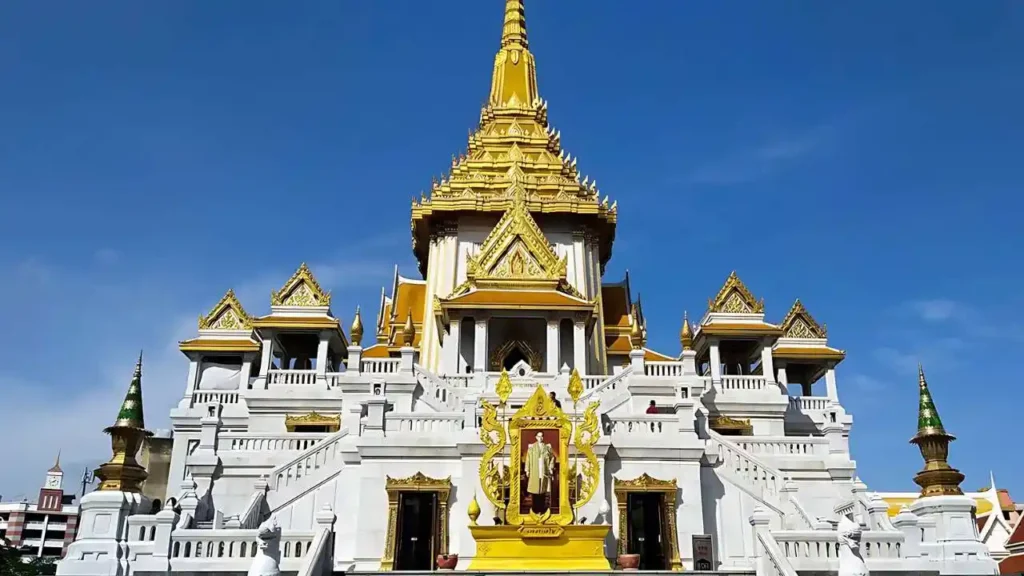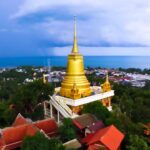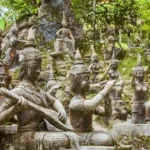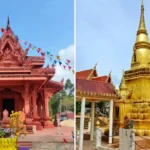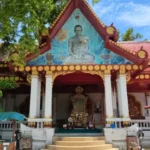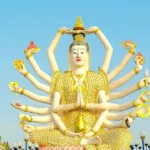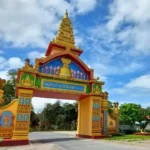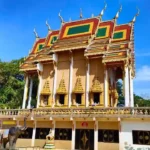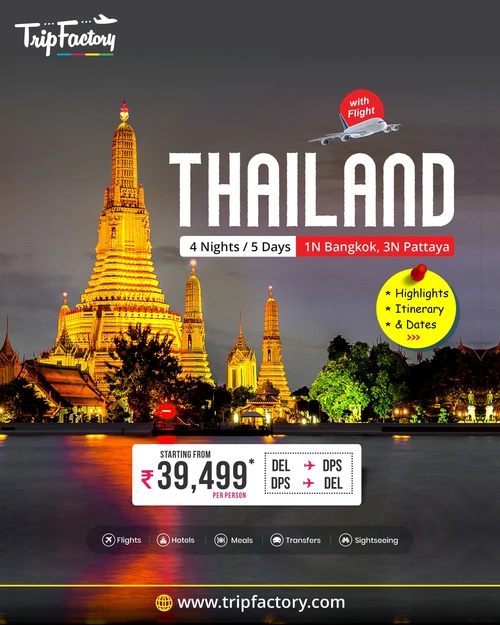Wat Traimit is a famous temple located in Bangkok’s historic old town, right in the heart of the Yaowarat Chinatown district. It’s especially famous for being home to the world’s largest Buddha statue, crafted entirely from solid gold. The full name of Wat Traimit is Wat Traimit Withayaram Worawihan. Most people, including locals, simply call it Wat Traimit.
Also, it is referred to as “The Temple of the Golden Buddha” Officially, the Golden Buddha is called Phra Phuttha Maha Suwanna Patimakon because of its inconvenience in spelling; it is so it’s often shortened to Phra Sukhothai Traimit for convenience.
About Wat Traimit
Wat Traimit is famous for its Golden Buddha, also known as Phra Phuttha Maha Suwana Patimakon. Specifically, this statue weighs approximately 5.5 tons and is made of pure gold. Moreover, it is believed to date back to the 13th or 14th century.
Additionally, it holds the distinction of being the world’s largest solid gold Buddha statue. The Golden Buddha was created during the Sukhothai period and was later moved to Bangkok. To protect it from Burmese invaders, it was cleverly covered in plain plaster, which concealed its true value.
For centuries, no one knew what lay beneath the surface until 1955, when the statue was being moved, and a portion of the plaster accidentally came off, revealing the gleam of solid gold underneath. Since then, the statue has been placed in a beautifully restored temple building, featuring a traditional Thai-style roof, elegant marble railings, and a touch of Chinese influence.
Location:
Wat Traimit is situated near Hua Lamphong Railway Station. Which is at the beginning of Bangkok’s Chinatown area.
How to Reach Wat Traimit?
You can reach Wat Traimit Witthayaram Worawihan by train, bus or taxi.
By Public BTS Skytrain
If you’re starting in the Rattanakosin area, the easiest way to get to Wat Traimit is to first head to the nearest BTS Skytrain station, usually Saphan Taksin, which is about a 10-minute ride by taxi or tuk-tuk.
From there, grab a ticket to Chao Phraya River Station. Once you get off, it’s a 10-minute walk to Sathorn Pier (also known as Central Pier). From there you get on a river boat heading to Ratchawong Pier. The boat fare is typically between 15 to 30 THB.
After getting off at Ratchawong, it’s about a 15-minute walk to Wat Traimit, located at 661 Charoen Krung Road.
By Public Bus
Another budget-friendly option is to get on a bus heading towards Charoen Krung Road.
Look for bus routes that go through the Samphanthawong district. Buses 1, 8, and 25. The fare is usually around 8 to 15 THB. Once you get off near the area, it’s just a short walk to Wat Traimit, which sits at 661 Charoen Krung Road.
By Taxi or Grab App
Depending on traffic and where you’re starting from in Rattanakosin, you can take a taxi or book a ride through the Grab app, which is considered the best choice for tourists and travellers.
Simply enter ‘Wat Trai Mit Witthayaram Worawihan’ or use the address 661 Charoen Krung Road in the app. The fare usually falls between 50 to 100 THB, and the journey typically takes around 15 to 30 minutes.
Timings / Opening Hours
Temple Hours: 8:00 AM – 5:00 PM (daily)
Museum Hours (inside the temple): 9:00 AM – 5:00 PM
Tips: It’s best to visit early in the morning to avoid the crowds and heat.
Tickets and Entrance Fees
- Thai Citizens: Free
- Foreign Visitors: Entry to the Golden Buddha hall: 40 THB
- Entry to the museum (on the 2nd floor): 100 THB
- Combo tickets may be available at the counter depending on the day.
- Dress Code: When dressing, please wear long pants or skirts, sleeved shirts (no tank tops), and ensure your shoulders are covered, along with closed shoes or sandals with straps.
More Temples in Bangkok
The Grand Palace | Wat Arun Ratchawararam |
| Wat Pho | Wat Phra Kaew |
| Erawan Shrine | Wat Saket |
| Wat Benchamabophit | Wat Suthat |
| Wat Saman Ratanaram | Wat Rakhangkhositaram |
Things to Do in Wat Traimit
Visit The Famous Golden Buddha
Start your visit with one of Thailand’s most iconic statues, of 5.5-ton solid gold Buddha statue.
Standing almost 5 meters tall, it’s not just massive but also beautifully detailed, symbolising wisdom and enlightenment. also known as the Golden Buddha or Phra Sukhothai Traimit. The views from the top floor are beautiful, you’ll be able to enjoy the scenic views of Bangkok’s old town district.
Visit the 3rd Floor Museum
Visit the third floor for a closer look at the backstory of the Golden Buddha. The museum guides you through its construction, unique features, and the incredible journey it underwent before arriving at Wat Traimit.
Chinatown Heritage Centre
On the first floor of the Phra Maha Mondop, you’ll find the Chinatown Heritage Centre, a great spot to explore. Bangkok’s famous Chinatown tells the story of the Chinese immigrant community that helped shape the area.
By exploring exhibits, old photographs, and cultural artifacts, you will gain a deeper understanding of how Chinese traders and settlers have shaped Bangkok’s economy, traditions, and daily life throughout the centuries.
Kuan Yim Shrine
Kuan Yim Shrine, dedicated to the Goddess of Mercy, also known as Guanyin or Kuan Yim in Thai. This shrine is a peaceful corner where visitors come to pray for compassion, healing, and guidance. People often come here to light incense, make offerings, and silently pray. The place is quiet and respectful.
According to the atmosphere of the shrine, this place invites you to pause, slow down, and take in a different aspect of spiritual life at the temple.
Relax at Romaneenart Park
Romaneenart Park offers a peaceful break from the busy streets of Bangkok. Interestingly, this park used to be a prison, but it’s been beautifully reconstructed into a green urban space with landscaped gardens, ideal for walking and jogging paths, and charming ponds.
It’s the perfect spot to relax after your temple visit, and you can have a quiet picnic, sit under the trees, or just watch locals enjoying their day.
Best Time To Visit
The best time to visit Wat Traimit is between November and early February, when Bangkok has cooler and more pleasant weather (around 20°C to 32°C). It’s also peak tourist season, so the temple feels lively with cultural events happening around the city. Just try to go early in the day to avoid the crowds, especially on weekends or public holidays.
Another great time is during Buddhist holidays like Visakha Bucha Day (usually in May or June). Visiting then gives you a chance to see traditional Thai religious ceremonies in action. No matter when you go, remember to dress respectfully (cover shoulders and knees) since it’s a sacred site.
Tips: Try to avoid the rainy season (July–October)
Is visiting Wat Trai temple worth it?
Wat Traimit, widely known as the Golden Buddha Temple, is one of Bangkok’s most iconic landmarks, located in the heart of one of the world’s largest Chinatowns. The temple itself is beautifully built with white marble and golden accents, giving it an elegant and regal look.
The entry fee is 100 Baht (about $3), and to see the main highlight the 5.5-ton solid gold Buddha, all you’ll need to do is to climb three flights of stairs, which may be a bit challenging for some visitors. But the statue is truly impressive, consisting of polished gold without the typical gold leaf coverings, which can be seen in many other temples.
While it’s hard to believe it’s entirely solid gold, that’s exactly what makes it so fascinating. Regardless of any doubts, this place is worth a visit, both for its beauty and the story behind it.
More Places to Visit Nearby
Chinatown
Since Wat Traimit is right next to Chinatown, it’s a great idea to explore the area while you’re there. Bangkok’s Chinatown is full of life, with bustling street markets, gold shops, traditional Chinese eateries, temples, second-hand stores, and colourful signs lining narrow streets.
What makes it special is that, despite its busy vibe, the neighbourhood has held onto its authentic charm and hasn’t been overtaken by modern commercial development.
China Gate
Chinatown’s main entrance is marked by the China Gate, which is at the busy Odeon Circle where five streets meet. On each side of the gate, there are two white jade statues: a lion and a rabbit.
It is believed that placing your wallet in the lion’s mouth can bring good luck and wealth. The jade rabbit, on the other hand, was a gift from China in honour of the 2011 Year of the Rabbit.
Angkor National Museum Tourism
The Angkor National Museum in Siem Reap, Cambodia, is a modern museum that offers a deep dive into the Khmer Empire’s rich cultural heritage. Explore the iconic Angkor Wat temple that offers a detailed perspective of the Khmer architectural masterpiece.
Lumpini Park
Lumpini Park is more than just a recreational area. Covering over 500,000 square meters, the park was established in the 1920s by King Rama VI and named after Lumbini, the birthplace of Buddha in Nepal.
It’s home to a rich variety of native plants, birds, and even monitor lizards. Visitors can enjoy boating, jogging and walking tracks, outdoor gyms, and playgrounds. The park regularly hosts cultural events, live performances, and group activities like Tai Chi and aerobics.
Its location near Bangkok’s commercial hubs makes it an interesting spot to discover favourite for both locals and tourists.

